Overview:
The WNBA’s top players made a statement at the 2025 All-Star Game, wearing black T-shirts that read “Pay Us What You Owe Us.” This coordinated show of solidarity was aimed at the league’s existing labor agreement, with players raising concerns about revenue distribution, bonuses, and the inflexibility of roster and salary rules. The WNBA players’ compensation, benefits, and overall financial structure are significantly lower than that of the NBA, highlighting the core of the WNBA players’ fight for equity. The players are asking for a fair share of what they help generate, and the league has a decision to make: match the investment players have made in the WNBA or risk losing the foundation of its future.
The 2025 WNBA All-Star Game in Indianapolis wasn’t just a spectacle—it was a statement.
Before tip-off at Gainbridge Fieldhouse, the league’s top players walked onto the court wearing black T-shirts with a bold message: “Pay Us What You Owe Us.”
This coordinated show of solidarity was more than symbolic. It was a clear and calculated message aimed at the WNBA’s existing labor agreement—the 2020–2027 Collective Bargaining Agreement (CBA). More than just a moment, it marked the latest chapter in a labor fight that has increasingly played out in public view.
The Opt-Out: A Bold Step Forward
Behind the scenes, nearly 50 players met in a union-led strategy session, signaling the seriousness of their cause. The stakes were higher than ever. And the statement didn’t end at the final whistle.
“We play a huge part in this. We feel like we should be rewarded for that.”
Paige Bueckers, Dallas Wings rookie and no.1 2025 draft pick
After the game, Washington Mystics guard Brittney Sykes walked to center court and raised a sign that read, “Pay The Players.” Sykes embodied the movement’s resolve.
The image quickly went viral—becoming a defining visual of a weekend that was about far more than basketball.
In October 2024, the WNBPA’s Board of Player Representatives and Executive Committee unanimously voted to opt out of the current CBA, invoking the agreement’s early termination clause. Although the original deal was slated to run through 2027, the opt-out forces the league and union to the negotiating table by the 2026 season—if not sooner.
This wasn’t a rash decision. For years, players have raised concerns about revenue distribution, how bonuses are structured, and the inflexibility of roster and salary rules under the league’s hard cap.
“We play a huge part in this,” said Dallas Wings rookie and 2025 No. 1 pick Paige Bueckers. “We feel like we should be rewarded for that.”
 Credit: April Verrett on X: “At the WNBA All-Star Game, players took the court in shirts that read “PAY US WHAT YOU OWE US.”
Credit: April Verrett on X: “At the WNBA All-Star Game, players took the court in shirts that read “PAY US WHAT YOU OWE US.”
If the two sides don’t come to terms, the WNBA could face its first-ever work stoppage. And for the players, that’s a risk worth taking.
Same Game, Different Realities
While the NBA and WNBA both operate under collective bargaining agreements that dictate pay, benefits, and league operations, the similarities stop there. The disparities in compensation, benefits, and overall financial structure between the leagues highlight the core of the WNBA players’ fight for equity.
 The NBA’s total revenue in 2017 was about $8.76 billion and $4.3 billion of it went to its players. The WNBA’s total revenue in 2017 was about $60 million and $20 million of it went to its players. Hence, NBA players receive 50 percent of the money the association generates, while WNBA players receive less than half of that amount from their association, at 24 percent. Chart by Coolkingsingh on Medium.com.
The NBA’s total revenue in 2017 was about $8.76 billion and $4.3 billion of it went to its players. The WNBA’s total revenue in 2017 was about $60 million and $20 million of it went to its players. Hence, NBA players receive 50 percent of the money the association generates, while WNBA players receive less than half of that amount from their association, at 24 percent. Chart by Coolkingsingh on Medium.com.
According to the 2023 NBA CBA, players receive between 49% and 51% of all Basketball Related Income (BRI), which supports a soft salary cap system exceeding $140 million per team for the 2024–25 season.
 There are two types of maximum base salaries — one standard maximum and a higher maximum for players who meet any of a number of criteria. The higher maximum base salary, which is often referred to as the “supermax”, is designed to reward elite veterans and incentivize young stars to remain with the teams who drafted them. The supermax is about 16% higher than the standard maximum. The standard maximum is for 14.2% of the salary cap and the supermax is for 16.5% of the salary cap. Graph from Jacob Mox.
There are two types of maximum base salaries — one standard maximum and a higher maximum for players who meet any of a number of criteria. The higher maximum base salary, which is often referred to as the “supermax”, is designed to reward elite veterans and incentivize young stars to remain with the teams who drafted them. The supermax is about 16% higher than the standard maximum. The standard maximum is for 14.2% of the salary cap and the supermax is for 16.5% of the salary cap. Graph from Jacob Mox.
Meanwhile, the 2020 WNBA CBA stipulates that players may receive up to 50% revenue sharing—but only if the league hits certain undisclosed growth targets, which have, to date, remained unmet. For 2025, the WNBA enforces a hard cap of approximately $1.46 million per team. While NBA teams have a wide array of salary cap exceptions designed to retain talent and offer contract flexibility, the WNBA’s rigid structure limits team-building and individual earning potential.
 Pay Gap – NBA Players vs WNBA Players Salaries. Graphic by Fisher Jack.
Pay Gap – NBA Players vs WNBA Players Salaries. Graphic by Fisher Jack.
The gap in compensation begins at the very start of a player’s career. According to the NBA’s rookie salary scale in the 2023 CBA, the No. 1 overall pick—like Cooper Flagg—can earn more than $10.1 million in their first year alone, on a four-year deal totaling over $55 million. In contrast, the WNBA’s rookie scale outlined in the 2020 CBA allots just $76,535 to the top pick in their first year, with Paige Bueckers’s entire four-year contract totaling roughly $324,000.
Both Flagg and Bueckers are generational players. Both went No. 1 overall in the same city. Yet, the financial realities they face are worlds apart.
Veteran Status Reveals More Disparities
Veteran contracts reveal an even wider chasm. Under the NBA’s current agreement, a 10-year veteran can earn up to 35% of the salary cap—equaling $47.6 million in the 2023–24 season.
 Players with two or fewer years of service are at the lowest level, while players with three or more years of service have a higher minimum base salary. For example, a free agent who played in 2017, 2018, and 2019 such as Erica McCall is governed by the higher minimum base salary.
Players with two or fewer years of service are at the lowest level, while players with three or more years of service have a higher minimum base salary. For example, a free agent who played in 2017, 2018, and 2019 such as Erica McCall is governed by the higher minimum base salary.
According to the WNBA CBA, the maximum salary for its most experienced players caps at just $241,984.
A WNBA player earning the league’s highest possible salary still takes home less than an NBA player on a minimum deal, which currently pays $2.4 million per year.
The disparity extends beyond base salaries into performance-based bonuses. The NBA’s CBA allows for multi-million-dollar incentives tied to awards and achievements. All-NBA selections can trigger $2–3 million in additional income, MVP awards often come with escalators worth millions, and players on the winning team of the NBA Cup receive $500,000 each.
Even assistant coaches in that tournament earn six-figure bonuses. In stark contrast, the WNBA awards just $15,450 to its MVP, $10,300 for All-WNBA First Team honors, and $2,575 for making the All-Star Game. Winning the WNBA Finals earns a player roughly $11,356. Even the league’s Commissioner’s Cup pays out $30,000 to each player on the winning team.
According to their respective CBAs, an NBA player can walk away from a midseason tournament with more cash than a WNBA MVP earns in a full season.
When it comes to support and infrastructure, the NBA again operates on a different level. Its players fly charter across the board, have access to elite training facilities, personal chefs, relocation benefits, and year-round medical care tailored to individual performance. According to the NBA CBA, this includes extensive post-career income planning, 401(k) programs, and health and welfare benefits that extend well beyond a player’s final game.
In comparison, the WNBA—while more progressive in some areas like maternity leave and fertility support—only recently began offering charter flights for back-to-back road games and playoff travel.
According to the WNBA CBA, players can receive up to $5,000 per child in childcare stipends and as much as $60,000 in family planning reimbursement, but their overall compensation remains a fraction of what their male counterparts receive for the same output. The underlying reason for this divide is media revenue.
But players worry that the revenue won’t count toward the league’s elusive “growth targets,” which are required before they can claim a larger revenue share.
The NBA is finalizing a new 11-year, $76 billion media rights deal set to begin in 2025–26. That deal fuels BRI and underpins the league’s soft cap model. The WNBA’s new media deal—an 11-year, $2.2 billion agreement averaging $200 million annually—represents progress. But players worry that the revenue won’t count toward the league’s elusive “growth targets,” which are required before they can claim a larger revenue share. As stated by WNBPA President Nneka Ogwumike, “We see the growth. We see the fans, the sponsors, the media attention. But the compensation system hasn’t caught up.”
Expansion Brings Buzz—but Not Yet Equity
The WNBA is clearly growing. The Golden State Valkyries debuted in San Francisco in 2025. In 2026, the Toronto Tempo will become the first international WNBA team, while Portland will return to the league.
Additional expansion teams in Cleveland, Philadelphia, and Detroit are already being discussed. Franchise fees have skyrocketed: Golden State reportedly paid $50 million to join, Toronto $115 million, and Portland $125 million. And yet, the players still wait for compensation that matches the value they bring.
What Comes Next?
With negotiations expected to intensify after the season, players are holding firm: visibility without equity is no longer acceptable.
“We’ve done everything right,” said Plum. “We’ve grown the game, packed arenas, worn mics, done the marketing. And we’re still being asked to wait.”
Now the ball is in the league’s court.
Why WNBA Players Deserve More
Since tipping off in 1997, the WNBA has evolved into a legitimate entertainment brand. In 2023, attendance jumped 21%—the highest in more than a decade. Social media engagement is booming thanks to stars like Caitlin Clark, Angel Reese, and Paige Bueckers.
 Players collectively decided to wear “Pay Us What You Owe Us” T-shirts during All-Star Game warm-ups. League stars such as Bueckers, Clark and Reese were included in the matching lineup.
Players collectively decided to wear “Pay Us What You Owe Us” T-shirts during All-Star Game warm-ups. League stars such as Bueckers, Clark and Reese were included in the matching lineup.
(Grace Smith/IndyStar / USA TODAY NETWORK via Imagn Images)
Sponsorships have followed. Brands like Nike, Google, and Coinbase are investing in the league. SKIMS signed a multiyear partnership in 2024, and players are starring in national campaigns for Beats by Dre, Gatorade, and Wilson.
And the fans are showing up. The 2025 All-Star Game and NCAA Final Four proved women’s basketball is both popular and profitable. ESPN’s broadcast of the women’s NCAA title game even outdrew the men’s final for the first time ever.
So why are WNBA players still being paid like afterthoughts?
They aren’t asking for NBA money. They’re asking for a fair share of what they help generate.
With league expansion, record media rights, sold-out arenas, and global momentum, the WNBAis clearly on the rise. But if the very players fueling that rise aren’t seeing the rewards, the system isn’t just outdated—it’s exploitative.
This next CBA isn’t just about salary figures. It’s about respect, sustainability, and dignity. The league has a decision to make: match the investment players have made in the WNBA—or risk losing the foundation of its future.
“Pay Us What You Owe Us” isn’t just a slogan. It’s a line in the sand.
Related

